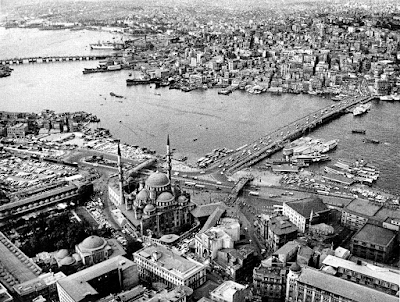 |
| Ara Güler, Istanbul (1962) |
Sometimes you can know a place without ever having been there.
I feel that way about Istanbul.
It came about because during a few months in 2010, when I was caring for my mother, I read all of the books of the Turkish author (and Nobel Prize in Literature winner) Orhan Pamuk.
I was looking through some papers yesterday, and found notes that I made while reading Pamuk's Istanbul: Memories and the City, which consists of a series of essays about the city. It reminded me of how those essays made the city come alive for me. I wrote notes on just about every essay, and circled the names of my favorites in red pen (often accompanied by three, four, or five stars!).
Here are some of my favorites, the chapters that have brought Istanbul alive in my imagination. (With accompanying photos by the great Turkish photographer, Ara Güler, lauded by Pamuk.)
Chapter 36 The Ship on the Golden Horn (Ferry Ride)
 |
| Ara Güler, [ferry] |
This chapter in particular describes a turning point, where Pamuk becomes re-anchored (or re-moored) by walking the city, and by collecting stuff. It is this sensibility, I think, that defines him as a novelist and as an artist, and the discovery of this practice seems to have been for him the moment of his salvation.
Chapter 10 Hüzün
 |
| Ara Güler, Karakoy (1959) |
It reminded me of my study of other cultures, and the way specific types of feelings or attitudes can be characteristic of a particular people.
For instance, this made me think of the way a slightly different type of melancholy -- mono no aware -- is often said to be a quintessential Japanese sentiment. (And it made me think of a great Japanese novelist, Jun'ichirō Tanizaki, and his book on Japanese aesthetics, In Praise of Shadows, which deals with mono no aware.
Chapter 18 Reşat Ekrem Koçu's Collection of Facts and Curiosities: The Istanbul Encyclopedia
Pamuk delves into the impulse to create, and to consume, collections of facts, and of stories -- showing how it is sort of the natural hobby of anyone who is also capable of falling in love with a robust city.
There is a natural link to the work of a city's popular press, and the columnists who find employment filling its pages with stories.
 |
| Turkish edition of Istanbul: Memories and the City (showing Pamuk in his formative years) |
. . . and much more . . .
Other chapters I loved were more about Pamuk and his personal and artistic formation, rather than the city itself. These included Chapter 8 My Mother, My Father, and Various Disappearances; Chapter 12 My Grandmother; Chapter 28 Painting Istanbul; and Chapter 35 First Love.
Postscript: Flying Over Istanbul
I traveled to Palestine in March, 2015, and our group flew on Turkish Airlines and transited Istanbul.
It was a thrill for me to see the harbor and the city all around us as our plane descended toward the airport. (As I had imagined, it was very reminiscent of Hong Kong!)
I've gotten close to the real thing! All that remains is to go the next step and leave the airport!
 |
| Istanbul from above (More at skyscrapercity.com) |
Related posts
I often refer to how important the films of Iran have been in helping me open my mind to the possibilities of a peaceful relationship with that country. I have been fortunate to be able to go see some of the best films from Iran every year at the wonderful Siskel Film Center in downtown Chicago. The will be another Festival of Films From Iran showing there in February, 2014.
(See A Force for Peace: Getting to Know Iran Through Film)
Years later, during the time I was busily traveling to China, Taiwan, Hong Kong, Japan, South Korea, Thailand, Malaysia, and many other places, I had occasion one day to flip open my (real) passport, and all the extension pages, filled with visa stamps, cascaded out. The memory of Expo 67 and my "globetrotting" came rushing back to me . . .
(See O Canada! (We'll always have "Expo" . . . . ))
I could go on and on about City of Sadness: about everything from the sound of slippers scraping across the floor to the history of the 228 incident that the film illuminates . . . the funeral scene, and the wedding scene . . . . But more than anything, it's about Taiwan nature, Taiwan separateness, and Taiwan rebelliousness.
(See Taiwan Through "City of Sadness")



No comments:
Post a Comment